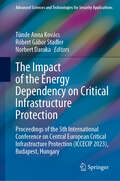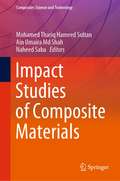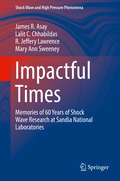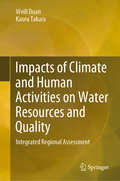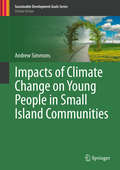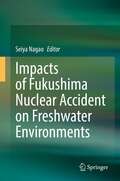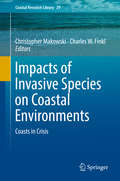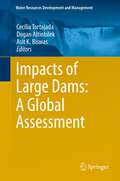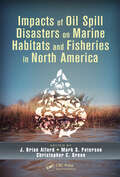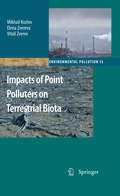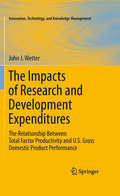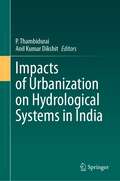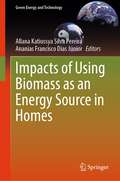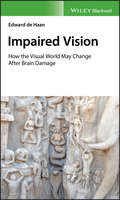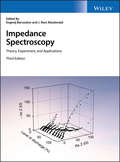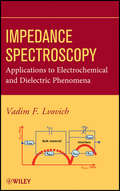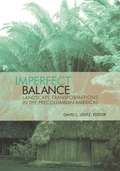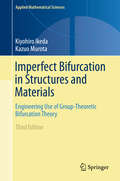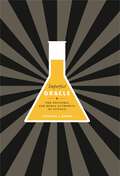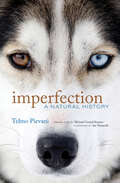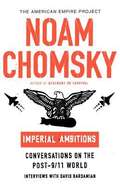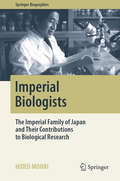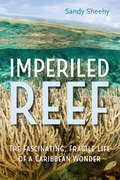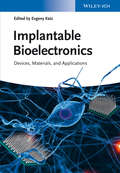- Table View
- List View
The Impact of the Energy Dependency on Critical Infrastructure Protection: Proceedings of the 5th International Conference on Central European Critical Infrastructure Protection (ICCECIP 2023), Budapest, Hungary (Advanced Sciences and Technologies for Security Applications)
by Tünde Anna Kovács Róbert Gábor Stadler Norbert DarukaThis book presents cutting-edge research on the impact of energy dependence and strategies to mitigate it. As a crucial component of critical infrastructure, energy security is a top priority for nations worldwide. The protection of this infrastructure, along with the latest research tools and methodologies, is of significant interest to both policymakers and industry leaders. The book delves into two primary areas of research: cybersecurity and physical security, summarizing the latest findings in these critical fields. The papers in this volume offer valuable insights for both academic and industrial audiences, addressing the pressing challenges of energy security. Energy is integral to every aspect of our daily lives. Our comfort, as well as our safety, hinges on the uninterrupted supply of energy. Recent global events, particularly the Russian-Ukrainian war, have underscored the vulnerability of nations lacking sufficient energy resources. Europe's energy supply has been severely disrupted by sanctions, highlighting the need for energy resilience. However, this crisis has also accelerated the adoption of renewable energy sources, marking a pivotal shift towards sustainable energy solutions.
Impact Studies of Composite Materials (Composites Science and Technology)
by Mohamed Thariq Hameed Sultan Ain Umaira Md Shah Naheed SabaThis book discusses the impact of different range of velocities (low, high, ballistic and hyper-velocity impact) on composites. Presented through experimental and numerical analysis, the book goes beyond impact event analysis and also covers the after-impact phenomena, including flexural and compression and damage analysis through destructive and non-destructive evaluations. The analyses presented from either experimental or numerical simulations are composed of micro and macrographs images, illustrations, tables and figures with inclusive discussions and supportive evidences from recent studies on composites. This book also highlights the potential applications of composites through the lens of their impact properties, in different industries such as automotive and defence applications. Generally, this book benefits wider range of readers including the industrial practitioners, researchers, lecturer and students, who are working in the fields related to impact and damage analysis, including the structural health monitoring of composites, either experimentally or numerically.
Impactful Times
by James R. Asay Lalit C. Chhabildas R. Jeffery Lawrence Mary Ann SweeneyThis book presents a history of shock compression science, including development of experimental, material modeling, and hydrodynamics code technologies over the past six decades at Sandia National Laboratories. The book is organized into a discussion of major accomplishments by decade with over 900 references, followed by a unique collection of 45 personal recollections detailing the trials, tribulations, and successes of building a world-class organization in the field. It explains some of the challenges researchers faced and the gratification they experienced when a discovery was made. Several visionary researchers made pioneering advances that integrated these three technologies into a cohesive capability to solve complex scientific and engineering problems. What approaches worked, which ones did not, and the applications of the research are described. Notable applications include the turret explosion aboard the USS Iowa and the Shoemaker-Levy comet impact on Jupiter. The personal anecdotes and recollections make for a fascinating account of building a world-renowned capability from meager beginnings. This book will be inspiring to the expert, the non expert, and the early-career scientist. Undergraduate and graduate students in science and engineering who are contemplating different fields of study should find it especially compelling.
Impacts of Climate and Human Activities on Water Resources and Quality: Integrated Regional Assessment (Springer Geography Ser.)
by Weili Duan Kaoru TakaraWith the rapid increase of world population, the global water shortage is set to be the major crises of the twenty-first century; that is, population dynamics (growth, age distribution, urbanization and migration) create pressures on freshwater resources due to the increased water demands and pollution. Moreover, water resources management faces a new uncertainty- i.e. the potential for longer-term and more persistent climate change nowadays, which, in coming years, may significantly affect the availability of supply and patterns of water demand. This book mainly focuses on the impact of climate change and human activities on water quality and water resources in Asia Countries. It begins by describing the characteristics of water related disasters in the world. Then, the book analyzes the changes of floods and associated socio-economic damages for whole China over the last century, and assesses water quality and pollution source for the Yangtze River Basin, suggesting water-related disasters would become more intense, longer lasting, and/or more frequent in a future warmer climate. Then, after investigating spatiotemporal trends and causes of water quality and water quality incidents (Chapter 4) and precipitation extreme events (Chapter 5) in Japan, subsequent two chapters mainly evaluate the climate and human impacts on precipitation variations, water quality and water resources in the Hokkaido area. The final chapter comprehensively analyzes climate change impacts on water resources in the Aral Sea Basin, and then estimate the water requirements and water deficits for irrigation, future agricultural yields of seven major crops, and land and water productivity in four provinces of Turkmenistan considering climate change, population growth, and three socio-economic development scenarios. All results obtained from this book may provide a means to reduce water quality incidents and mitigate future negative impacts by adapting water management. Furthermore, the improved methods for water quality modeling in data scarce regions are transferable to other study areas and applicable in future research.
Impacts of Climate Change on Young People in Small Island Communities (Sustainable Development Goals Series)
by Andrew SimmonsThis book presents a comprehensive overview of the history, definition, causes, effects, impacts and implications of climate change on young people globally, with a focus on Small Island Communities (SIDS) in particular. The text highlights the key problems associated with the impact of climate change on young people in SIDS, specifically its effects on socio-economic development and livelihoods, and explores the need for the development of a new conceptual framework to deal with building the resilience of the adaptive capacity of youth in SIDS. The book analyzes the strengths and weaknesses of the emerging phenomenon of Global Youth Climate Change Movements/Actions, and examines the management/governance challenges associated with the Movement in terms of its operational mechanism, mobilization strategies and its use of social media/technology to mobilize mass action. The text concludes with a recommendation for further research in this area as a way to understand how the Movement functions and its mechanism for implementation of future research.
Impacts of Fukushima Nuclear Accident on Freshwater Environments
by Seiya NagaoThis book examines the impacts of radionuclides released from the 2011 Fukushima Daiichi Nuclear Power Plant (FDNPP) accident on inland aquatic environments. The focus is on the dynamics of radiocesium in inland aquatic environments.The book comprises three parts: migration behavior of radiocesium in river and lake environment, accumulation of radiocesium into organisms in freshwater, and integrated environmental analysis in a lake system and a forest-freshwater system. Many studies on the dynamics of radionuclides have been published after the FDNPP accident, especially of radiocesium (134Cs 137Cs) in land and marine environment. The key features of this book are the new data of freshwater environment including transport of radionuclides in river and lake watershed, and accumulation of radiocesium in freshwater fishes and insects. Another feature of this book is that it summarizes the dataset of a model lake, Lake Akagi-Onuma, from geochemical and biological approaches.Readers will learn the actual dispersion behavior of radionuclides released from the Fukushima accident and their impacts on freshwater environments since the accident in 2011. The book presents valuable information for assessing the impacts of the FDNPP accident on ecosystem and human health, which are also useful in developing countermeasures for similar accidents and environmental contaminations.
Impacts of Invasive Species on Coastal Environments: Coasts in Crisis (Coastal Research Library #29)
by Christopher Makowski Charles W. FinklThis book focuses on the global threats to coastal environments from invasive, non-native species and examines how these alien biological species adversely alter landscapes and socioeconomic conditions as well as the psychological attitudes and perceptions of local inhabitants and tourists. Designed for the professional or specialist in marine science, coastal zone management, biology, and related disciplines, this volume appeals to those not only working directly with invasive flora and fauna species, but also those individuals involved in a wide array of coastal related fields. Examples and case studies of coastal invasive species are drawn from many different geographic areas worldwide, including North and South America, Europe, Oceania, the Caribbean, Southeast Asia, and Africa.
Impacts of Large Dams: A Global Assessment
by Cecilia Tortajada Dogan Altinbilek Asit K. BiswasOne of the most controversial issues of the water sector in recent years has been the impacts of large dams. Proponents have claimed that such structures are essential to meet the increasing water demands of the world and that their overall societal benefits far outweight the costs. In contrast, the opponents claim that social and environmental costs of large dams far exceed their benefits, and that the era of construction of large dams is over. A major reason as to why there is no consensus on the overall benefits of large dams is because objective, authoritative and comprehensive evaluations of their impacts, especially ten or more years after their construction, are conspicuous by their absence. This book debates impartially, comprehensively and objectively, the positive and negative impacts of large dams based on facts, figures and authoritative analyses. These in-depth case studies are expected to promote a healthy and balanced debate on the needs, impacts and relevance of large dams, with case studies from Africa, Asia, Australia, Europe and Latin America.
Impacts of Oil Spill Disasters on Marine Habitats and Fisheries in North America (CRC Marine Biology Series)
by J. Brian Alford Mark S. Peterson Christopher C. GreenAt an increasingly global scale, aquatic scientists are heavily entrenched in understanding the fate of marine ecosystems in the face of human-altered environments. Oil spill disasters, especially large-scale ones like the 2010 Deepwater Horizon tragedy, have left uncertain and indelible marks on marine ecosystems. Impacts of Oil Spill Disasters on
Impacts of Point Polluters on Terrestrial Biota
by Elena Zvereva Mikhail Kozlov Vitali ZverevThis book is unique in identifying general patterns in responses of terrestrial biota to industrial pollution and the sources of variation in these responses. The meta-analysis is based on extensive original data on soils, plants and animals collected around 18 industrial polluters in six countries. The colour section is self-explanatory and informative, showing examples of severely polluted landscapes compared to pristine environment. This book will be a valuable source of information for ecologists, ecotoxicologists, and anyone interested to learn on how pollution affects wildlife on our planet.
The Impacts of Research and Development Expenditures
by John J. WetterThe research underlying this volume was designed to test the theory of Total Factor Productivity (TFP) in contemporary context. Developed by Nobel Prize-winning economist, Robert Solow, in the 1950s, TFP has been applied by many economists to investigate the relationships among capital, labor, and economic performance. In this analysis, John Wetter presents the hypothesis that technological investment drives growth and performance of the U.S. economy. The study addresses four key questions: 1. Is there a relationship between Total Factor Productivity and Gross National Product? 2. Is there a relationship between Total Factor Productivity and Research & Development expenditures? 3. Is there a relationship between Research & Development expenditures and Gross Domestic Product? 4. Can the relationship in research question #1 be explained by other factors? Is there any potential non-spuriousness (mediation) implication to the relationship? Synthesizing the literature from related fields, including macroeconomics, technology transfer, and innovation, and applying rigorous methodology, Wetter demonstrates that Total Factor Productivity is positively related to Gross Domestic Product and is mediated by Research & Development. In addition, he reveals that the lag time between R&D spending and GDP growth averages eleven years, which suggests that long-term planning is essential to maximizing the benefits of R&D. Wetter considers the implications for policymaking and industry leadership, including such timely issues as the effects of the 2009 U.S. stimulus program.
Impacts of Urbanization on Hydrological Systems in India
by P. Thambidurai Anil Kumar DikshitThis book documents the various impacts of urbanization on hydrological systems and water resources. The first half of the book is focused on urbanization and surface waters, starting with the status of hydrological systems in the urban areas, i.e. the catchment characteristics and changes in rainfall dynamics. The most pronounced hydrological problems in cities are changes in runoff due to precipitation. Recently, rain events have been less frequent but more intense, sometimes leading to flash floods. Though the substantial increase in runoff causes floods in the urbanized area, it may be attributed to the reduction of infiltration due to construction of roads. This, in turn, results in groundwater decline and depletion. The second half of the book covers the impact of urbanization on groundwater, which starts with hindered or significantly reduced recharge taking place due to altered urban surfaces. The limited groundwater resources are over-exploited by the urban population, leading to water scarcity and depletion. Groundwater gets polluted due to solid waste dumping sites or by wastewaters discharged by industries. The book will be useful for researchers, educators, municipal/city authorities, government officials, and NGOs.
Impacts of Using Biomass as an Energy Source in Homes (Green Energy and Technology)
by Allana Katiussya Silva Pereira Ananias Francisco Dias JúniorThe book deepens understanding of biomass sources and technologies used for cooking worldwide. It contributes directly to the creation of policies aimed at the mitigation of climate change.Historically, wood is considered humanity's first source of energy. Even after decades of use and industrialization processes, it is still considered the most important single source of renewable energy. About a third of the world's population is energetically dependent on wood for cooking and/or heating. Recently, the Covid-19 pandemic made it impossible to purchase fuels such as liquefied petroleum gas (LPG), forcing families in financial difficulties to opt for cheaper and more accessible sources of energy, such as wood and vegetable coal. This has been the picture of many families around the world and negatively impacts the environment and energy security. Considering that there are still many wood residues that are wasted and that tropical forests need to be conserved, knowledge about the energy use of wood residues is also essential. This is even more relevant when considering the significant volume of biomass coming from the sustainable management of the largest tropical forest in the world, the Amazon Forest.The book considers which wood variables should be taken into account when thinking about energy generation, how do food cooking technologies contribute to potentiating pollutants emissions, and how can these harmful effects be mitigated. It describes the chemical composition of biomass and the chemical compounds released during its burning, as well as their impacts on the environment and human health. It also presents the influence that technologies used in food cooking have on pollutant emissions and which alternatives can be used, such as the use of solar energy.
Impaired Vision: How the Visual World May Change after Brain Damage
by Edward de HaanAn unprecedented book that discusses a decades long journey of understanding vision and visual impairment through working with patients with brain damage Edward de Haan, a noted clinical vision researcher for the last 35 years, explains how the healthy brain deals with visual information and reveals how he learned to appreciate what it means to be visually impaired. Through discussions of fascinating case studies, he shows that visual deficits are individually unique. Some patients perceive the world without color, some see objects in a distorted manner, whilst others will claim that they can still see although they are demonstrably blind. The author details his experiences with these patients to demonstrate the manner in which patient work is a unique and vital part of discovering how the brain processes visual information. In doing so, Impaired Vision offers a review of the clinical symptoms related to visual impairment and highlights that the patient study method has not lost any of its relevance in our increasingly high-tech world. This important book: Explores the various clinical phenomena in visual impairment after brain damage Demonstrates the effectiveness of the patient study method for understanding visual deficits after brain damage Contains comprehensive coverage of the variety of symptoms that are manifest in patients with visual impairment Includes compelling case studies of visually impaired patients Written for a general audience but of interest for students, researchers and clinicians, Impaired Vision contains fascinating case studies that offer an understanding of the symptoms that are associated with visuals deficits of brain damage.
Impedance Spectroscopy: Theory, Experiment, and Applications
by Evgenij Barsoukov J. Ross MacdonaldThe Essential Reference for the Field, Featuring Protocols, Analysis, Fundamentals, and the Latest Advances Impedance Spectroscopy: Theory, Experiment, and Applications provides a comprehensive reference for graduate students, researchers, and engineers working in electrochemistry, physical chemistry, and physics. Covering both fundamentals concepts and practical applications, this unique reference provides a level of understanding that allows immediate use of impedance spectroscopy methods. Step-by-step experiment protocols with analysis guidance lend immediate relevance to general principles, while extensive figures and equations aid in the understanding of complex concepts. Detailed discussion includes the best measurement methods and identifying sources of error, and theoretical considerations for modeling, equivalent circuits, and equations in the complex domain are provided for most subjects under investigation. Written by a team of expert contributors, this book provides a clear understanding of impedance spectroscopy in general as well as the essential skills needed to use it in specific applications. Extensively updated to reflect the field’s latest advances, this new Third Edition: Incorporates the latest research, and provides coverage of new areas in which impedance spectroscopy is gaining importance Discusses the application of impedance spectroscopy to viscoelastic rubbery materials and biological systems Explores impedance spectroscopy applications in electrochemistry, semiconductors, solid electrolytes, corrosion, solid state devices, and electrochemical power sources Examines both the theoretical and practical aspects, and discusses when impedance spectroscopy is and is not the appropriate solution to an analysis problem Researchers and engineers will find value in the immediate practicality, while students will appreciate the hands-on approach to impedance spectroscopy methods. Retaining the reputation it has gained over years as a primary reference, Impedance Spectroscopy: Theory, Experiment, and Applications once again present a comprehensive reference reflecting the current state of the field.
Impedance Spectroscopy
by Vadim F. LvovichThis book presents a balance of theoretical considerations and practical problem solving of electrochemical impedance spectroscopy. This book incorporates the results of the last two decades of research on the theories and applications of impedance spectroscopy, including more detailed reviews of the impedance methods applications in industrial colloids, biomedical sensors and devices, and supercapacitive polymeric films. The book covers all of the topics needed to help readers quickly grasp how to apply their knowledge of impedance spectroscopy methods to their own research problems. It also helps the reader identify whether impedance spectroscopy may be an appropriate method for their particular research problem. This includes understanding how to correctly make impedance measurements, interpret the results, compare results with expected previously published results form similar chemical systems, and use correct mathematical formulas to verify the accuracy of the data. Unique features of the book include theoretical considerations for dealing with modeling, equivalent circuits, and equations in the complex domain, review of impedance instrumentation, best measurement methods for particular systems and alerts to potential sources of errors, equations and circuit diagrams for the most widely used impedance models and applications, figures depicting impedance spectra of typical materials and devices, extensive references to the scientific literature for more information on particular topics and current research, and a review of related techniques and impedance spectroscopy modifications.
Imperfect Balance: Landscape Transformations in the Pre-Columbian Americas (Historical Ecology Series)
by Lentz David L. Ed.We often envision the New World before the arrival of the Europeans as a land of pristine natural beauty and undisturbed environments. However, David Lentz offers an alternative view by detailing the impact of native cultures on these ecosystems prior to their contact with Europeans. Drawing on a wide range of experts from the fields of paleoclimatology, historical ecology, paleontology, botany, geology, conservation science, and resource management, this book unlocks the secret of how the Western Hemisphere's indigenous inhabitants influenced and transformed their natural environment.A rare combination of collaborators uncovers the changes that took place in North America, Mexico, Central America, the Andes, and Amazonia. Each section of the book has been comprehensively arranged so that a botanical description of the natural vegetation of the region is coupled with a set of case studies outlining local human influences. From modifications of vegetation, to changes in soil, wildlife, microclimate, hydrology, and the land surface itself, this collection addresses one of the great issues of our time: the human modification of the earth.
Imperfect Bifurcation in Structures and Materials: Engineering Use of Group-Theoretic Bifurcation Theory (Applied Mathematical Sciences #149)
by Kiyohiro Ikeda Kazuo MurotaMost physical systems lose or gain stability through bifurcation behavior. This book explains a series of experimentally found bifurcation phenomena by means of the methods of static bifurcation theory.
Imperfect Oracle: The Epistemic and Moral Authority of Science (G - Reference, Information and Interdisciplinary Subjects)
by Theodore L. BrownScience and its offshoot, technology, enter into the very fabric of our society in so many ways that we cannot imagine life without them. We are surrounded by crises and debates over climate change, stem-cell research, AIDS, evolutionary theory and “intelligent design,” the use of DNA in solving crimes, and many other issues. Society is virtually forced to follow our natural tendency, which is to give great weight to the opinions of scientific experts. How is it that these experts have come to acquire such authority, and just how far does their authority reach? Does specialized knowledge entitle scientists to moral authority as well? How does scientific authority actually function in our society, and what are the countervailing social forces (including those deriving from law, politics, and religion) with which it has to contend? Theodore Brown seeks to answer such questions in this magisterial work of synthesis about the role of science in society. In Part I, he elucidates the concept of authority and its relation to autonomy, and then traces the historical growth of scientific authority and its place in contemporary American society. In Part II, he analyzes how scientific authority plays out in relation to other social domains, such as law, religion, government, and the public sphere.
Imperfection: A Natural History
by Telmo PievaniIn praise of imperfection: how life on our planet is a catalog of imperfections, errors, alternatives, and anomalies.In the beginning, there was imperfection, which became the source of all things. Anomalies and asymmetries caused planets to take shape from the bubbling void and sent light into darkness. Life on earth is a catalog of accidents, alternatives, and errors that turned out to work quite well. In this book, Telmo Pievani shows that life on our planet has flourished and survived not because of its perfection but despite (and perhaps because of) its imperfection. He begins his story with the disruption-filled birth of the universe and proceeds through the random DNA copying errors that fuel evolution, the transformations of advantages into handicaps by natural selection, the anatomical and functional jumble that is the human brain, and our many bodily mismatches. Along the way, Pievani tells readers about the Irish elk (incidentally, neither Irish nor elk), whose enormous antlers serve to illustrate the first two laws of imperfection; the widespread dissemination of costly or useless traits; and the neuroimperfection of the human brain—&“a frozen accident of evolution that was not designed from scratch,&” as Pievani calls it. He sizes up the alleged perfection of the human body, asking, for example, if everything in our bodies serves a purpose, why do we have appendixes? Why bipedalism, with the inevitable back pain that results? In this fascinating account, Pievani offers the first comprehensive explanatory theory for the ubiquity of imperfection.
Imperfections in Crystalline Solids
by Wei Cai William D. NixThis textbook provides students with a complete working knowledge of the properties of imperfections in crystalline solids. Readers will learn how to apply the fundamental principles of mechanics and thermodynamics to defect properties in materials science, gaining all the knowledge and tools needed to put this into practice in their own research. Beginning with an introduction to defects and a brief review of basic elasticity theory and statistical thermodynamics, the authors go on to guide the reader in a step-by-step way through point, line, and planar defects, with an emphasis on their structural, thermodynamic, and kinetic properties. Numerous end-of-chapter exercises enable students to put their knowledge into practice, and with solutions for instructors and MATLAB programs available online, this is an essential text for advanced undergraduate and introductory graduate courses in crystal defects, as well as being ideal for self-study.
Imperial Ambitions: Conversations on the Post-9/11 World
by Noam Chomsky David Barsamian[From the book cover] Timely, illuminating, and urgently needed, this volume of interviews conducted by award-winning radio journalist David Barsamian features Noam Chomsky discussing U.S. policies in the increasingly unstable post-9/11 world. In these exchanges, appearing for the first time in print, Chomsky offers his frank, provocative, and informed views on the invasion and occupation of Iraq, the doctrine of preemptive strikes against so-called rogue states, and the growing threat to international peace posed by the U.S. drive for domination. In his inimitable style, Chomsky also dissects the propaganda system that fabricates a mythic past and airbrushes inconvenient facts out of history.
Imperial Biologists: The Imperial Family of Japan and Their Contributions to Biological Research (Springer Biographies)
by Hideo MohriThis book sheds light on a little-known aspect of the Imperial family of Japan: For three generations, members of the family have devoted themselves to biological research. Emperor Showa (Hirohito) was an expert on hydrozoans and slime molds. His son, Emperor Akihito, is an ichthyologist specializing in gobioid fishes, and his research is highly respected in the field. Prince Akishino, Emperor Akihito’s son, is known for his research on giant catfish and the domestication of fowl, while Prince Hitachi, Emperor Akihito’s brother, has conducted research on cancer in animals.The book shows how they became interested in biology, how seriously they were committed to their research, what their main scientific contributions are, and how their achievements are valued by experts at home and abroad.To commemorate the 60-year reign of Emperor Showa and his longtime devotion to biology, the International Prize for Biology was founded in 1985. The prize seeks to recognize and encourage researches in basic biology. A list of winners and a summary of their research are presented in the last part of the book.The author, an eminent biologist who has given lectures to the Imperial Family, explains their research and tells the fascinating story of biology and the Imperial Family of Japan. The book is a valuable resource, not only for biology students and researchers, but also for historians and anyone interested in science and the Royal and Imperial families.
Imperiled Reef: The Fascinating, Fragile Life of a Caribbean Wonder
by Sandy SheehyThe beauty and drama of a world beneath the surface of the waves This book brings alive the richly diverse world of an underwater paradise: the Mesoamerican Barrier Reef. Stretching 625 miles through the Caribbean Sea along the coasts of Mexico, Belize, Guatemala, and Honduras, this reef is the second largest coral structure on the planet. Imperiled Reef searches out the breathtaking intricacies of this endangered ecological treasure. Research shows that the future of the reef is at risk, Sheehy explains. Looking closely at threats ranging from global warming to overfishing to irresponsible development, Sheehy draws attention to the inspiring efforts of nongovernmental agencies, scientists, and local communities who are working together to address these challenges. She includes practical actions individuals can take to protect this reef—as well as marine ecosystems everywhere. Celebrating a vast, submerged landscape that has too often been undervalued, Imperiled Reef is both a strong case for protecting an international marvel and a powerful message of hope for the world’s oceans.
Implantable Bioelectronics
by Evgeny KatzHere the renowned editor Evgeny Katz has chosen contributions that cover a wide range of examples and issues in implantable bioelectronics, resulting in an excellent overview of the topic. The various implants covered include biosensoric and prosthetic devices, as well as neural and brain implants, while ethical issues, suitable materials, biocompatibility, and energy-harvesting devices are also discussed.A must-have for both newcomers and established researchers in this interdisciplinary field that connects scientists from chemistry, material science, biology, medicine, and electrical engineering.
